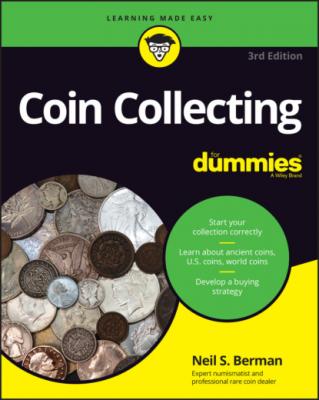Coin Collecting For Dummies. Neil S. Berman
Читать онлайн.| Название | Coin Collecting For Dummies |
|---|---|
| Автор произведения | Neil S. Berman |
| Жанр | Изобразительное искусство, фотография |
| Серия | |
| Издательство | Изобразительное искусство, фотография |
| Год выпуска | 0 |
| isbn | 9781119862697 |
Gold is popular because it’s
Rare: Gold is one of those metals that has been recognized as being rare and desirable for more than 6,000 years, but it isn’t so rare that it’s impossible to find.
A naturally occurring element: Gold is found in nature as flakes or nuggets on the surface of the Earth, in rivers, or in thin veins buried deep within the Earth. The purity of natural gold may vary from one location to the next, but it requires little processing to achieve a uniform quality. There’s gold to be found on every continent.
Malleable: Pure gold is soft and can be beaten into extremely thin sheets or pulled into long wires or strips. Because it’s so soft, gold takes good impressions from dies (the steel cylinders used to strike coins), and it won’t wear them out as fast as a harder metal would. Or it can be alloyed with other metals and made as hard as you want.
Reasonably inert: In nature or in normal use, gold won’t react with moisture, oxygen, or human skin, which means that jewelry and coins made of gold will last virtually forever.
Beautiful: Pure gold has a soft yellow color and a gorgeous sheen that has appealed to people’s visual senses since we lived in caves. Mix gold with silver or copper, and you’ll come up with an interesting range of colors. The colors that come up most frequently on U.S. gold coins are pale reds, light greens, soft pinks, and white.
Silver is popular because it’s
Common: Vast quantities of silver have been found in various parts of the world, including the United States, Mexico, and South America. Because it’s common, silver is the perfect metal for creating lower-value coins for use by the general public.
A naturally occurring element: Found deep within the Earth, silver is usually mixed with another great coinage metal: gold. Although native silver is perfectly good for casting into ingots and making into coins, most of it is processed to purify the silver and to separate out the more valuable gold.
Beautiful: Pure silver has a bright white luster and a deep brilliance. As it tarnishes, silver can acquire some lovely colors, including blues, reds, and purples, especially coins that have been stored near a source of sulfur, such as paper albums.
Commemorative coins
In the 1930s, numerous proposals for commemorative coins appeared before the U.S. Congress. Although many of the coinage bills had narrow appeal, they became law, and the U.S. Mint dutifully struck the coins (including the one shown in Figure 2-1), which were sold through distributors who added a premium above the face value of the coins. Members of the collecting public paid a premium for the coins and were happy to add them to their collections. But the U.S. Mint, producing a new coin every few months, almost seemed to be saying to collectors, “Here’s the latest commemorative. Please send your money — and by the way, there’s another commemorative coin coming out next month, so please be ready to send your money for that one as well.”
FIGURE 2-1: A commemorative coin.
Collectors complained that too many different coins were being produced and that speculators were manipulating the markets and prices. Both situations were true. The U.S. Mint got the hint, the flood of commemoratives slowed to a trickle, and collectors were happy again. In the late 20th century, the Mint went back to making tons of commemorative coins, and collectors started complained again. Keeping up with the new issues was becoming a costly proposition. Nevertheless, many new people were attracted to coin collecting by often-beautiful commemorative coins, just as they are by today’s commemorative coin designs. (In Chapter 13, I tell you more about these interesting coins.)
BU Rolls
In the late 1950s and early 1960s, collectors went nuts for BU rolls — those original bank-wrapped rolls of Brilliant Uncirculated coins (such as those shown in Figure 2-2). Collectors tried to obtain rolls of as many dates, denominations, and mintmarks as they could. Certain issues, such as the 1950-D nickel, were promoted as being rare, and prices shot up. One day, the public woke up and realized that coins with mintages in the millions weren’t rare and would never be rare. Today, the BU 1950-D nickel roll remains cheaper than it was 35 years ago, and new collectors can’t understand why BU penny rolls from the 1950s are so inexpensive. Like all good fads, the BU Roll craze created lots of new collectors.
FIGURE 2-2: BU rolls.
silver certificates
The front of old silver certificates (like the one shown in Figure 2-3) state that they’re redeemable on demand at a federally insured bank for one silver dollar (or, later, for silver). The U. S. paper silver dollar was exchangeable for a metal silver dollar from 1863 to 1968. In 1964, the government changed the law and said that it was no longer going to exchange paper money for silver money; it gave people until June 24, 1968, to exchange any silver certificates they had on hand. Since that date, the government has had no obligation to exchange silver certificates for silver or silver coins, although the certificates are still legal tender for all debts public and private. Because of their high numismatic value, though, some of these certificates have greater value as collector’s items than as money.
Andrey_Lobachev / Adobe Stock
FIGURE 2-3: Silver certificates.
Getting Excited about Collecting Today
As kids, we could ride our bikes to the bank on a Saturday morning and swapped our allowance for rolls of coins.
